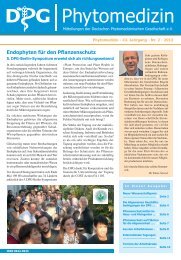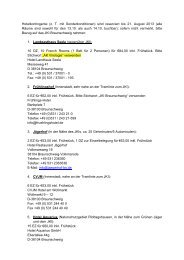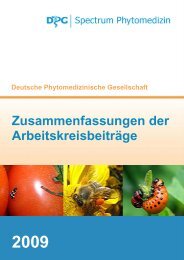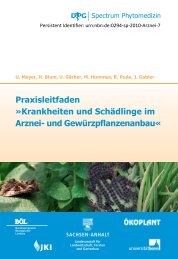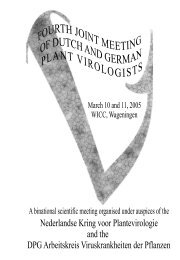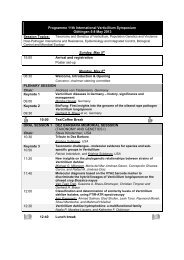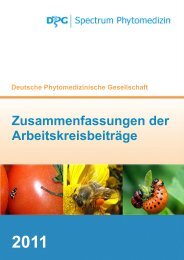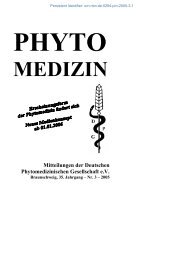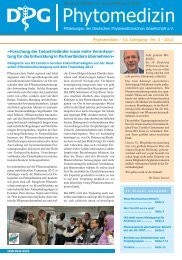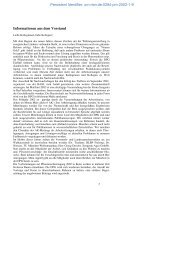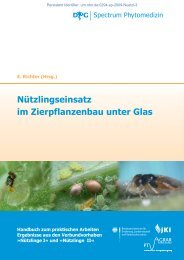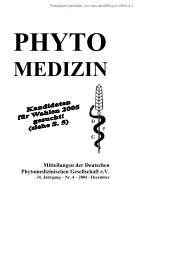03/2004 - Die DPG
03/2004 - Die DPG
03/2004 - Die DPG
- TAGS
- dpg.phytomedizin.org
Erfolgreiche ePaper selbst erstellen
Machen Sie aus Ihren PDF Publikationen ein blätterbares Flipbook mit unserer einzigartigen Google optimierten e-Paper Software.
Persistent Identifier: urn:nbn:de:0294-pm-<strong>2004</strong>-3-7<br />
reproducible quantitative trait loci (QTL) for aggressiveness were detected on<br />
linkage group I by simple interval analysis. A QTL linked to the TRI5 locus<br />
(trichodiene synthase in the trichothecene pathway gene cluster) explained<br />
51% of the variation observed and a second QTL some 50 cM away, 29% of<br />
the phenotypic variation. TRI5 is tightly linked to the locus controlling<br />
trichothecene toxin type. The two QTLs, however, were likely part of the<br />
same QTL by composite interval analysis. Progeny that produced deoxynivalenol<br />
were, on average, about twice as aggressive as were those producing<br />
nivalenol. No transgressive segregation for aggressiveness was detected. The<br />
rather simple inheritance of both traits in this interlineage cross suggests that<br />
relatively few loci for pathogenicity or aggressiveness differ between lineage<br />
6 and 7.<br />
Interactions between silicon, development of bacterial blight in tomato<br />
genotypes and the phenotype of Ralstonia solanacearum<br />
Wydra, K., und Dannon, E. Institut für Pflanzenkrankheiten und Pflanzenschutz,<br />
Herrenhäuser Str. 2, 30419 Hannover<br />
Silicon amendment reduced significantly bacterial wilt incidence expressed<br />
as area under disease progress curve for tomato genotypes L390 (susceptible)<br />
by 26.8% and King Kong2 (moderately resistant) by 56.1% compared to nontreated<br />
plants grown in hydroponic culture. However, wilt incidence in silicon-treated<br />
plants of genotype L390 reached 100% at 13 dpi, while in genotype<br />
King Kong2, plant death was retarded by 6 days, with 20% reduction of<br />
final wilt incidence. Bacterial numbers were significantly lower in silicontreated<br />
compared to non-treated plants in King Kong2 at 2 dpi in midstems<br />
and in all organs at 5 dpi, and in Hawaii 7998 (resistant) in all organs at 2dpi.<br />
Differences between genotypes were obvious on midstem level (5dpi), where<br />
bacterial populations were generally significantly lower compared to roots.<br />
Increased tolerance was observed in genotypes L390 and King Kong2 with<br />
silicon treatment.<br />
Silicon accumulated in roots and was low in stems and leaves. Inoculation<br />
with Ralstonia solanacearum did not significantly affect silicon uptake and<br />
distribution. Negative correlations between root silicon content and bacterial<br />
numbers of midstems in genotypes Hawaii 7998 and King Kong2 suggested<br />
an induced resistance. Indications for an influence of host genotype and silicon<br />
treatment on the phenotypic conversion of R. solanacearum from fluidal<br />
to non-fluidal colonies in planta were observed.<br />
36



